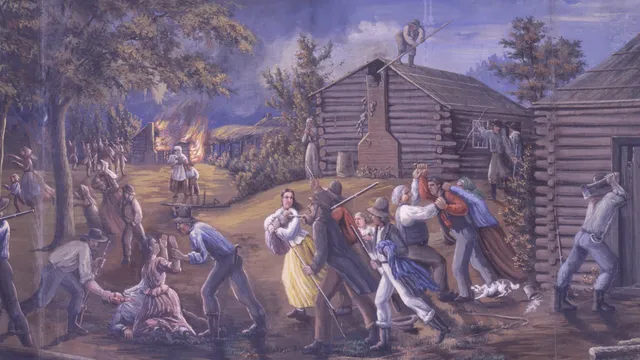
FAIR is a non-profit organization dedicated to providing well-documented answers to criticisms of the doctrine, practice, and history of The Church of Jesus Christ of Latter-day Saints.
FAIR › Scripture Study Resources: Supplement Your Come, Follow Me Study › Study Resources for the Doctrine & Covenants and Church History › Week 37 Be Still and Know That I Am God
DOCTRINE AND COVENANTS 98-101

The Saints in Missouri experienced great suffering, yet the Lord reminded them in Doctrine and Covenants 98:3 that “all things wherewith you have been afflicted shall work together for your good.” This doctrine teaches that trusting God’s process—even in suffering—can lead to personal sanctification and spiritual refinement.
In Doctrine and Covenants 98:39–40, the Lord teaches that if someone offends us and we forgive them, we are blessed and justified. If we don’t forgive, the greater sin rests with us. This principle promotes peace, unity, and Christlike love within the Church and in our personal relationships.
Verses 23–27 of Section 98 encourage turning the other cheek and not reviling in return. The Lord outlines steps for dealing with enemies that prioritize peace over retaliation. As disciples, we reflect Christ’s character by choosing peace in conflict.
The Lord outlines His expectations for Zion’s redemption through obedience to covenants, consecration, and a willingness to follow His timing (see D&C 101:3–6). This shows that Zion isn’t just a place, but a commitment to live the gospel fully and collectively.
If you have questions on this week’s reading, please email your questions to us here.
Practical solutions for someone in faith crisis:
Action Step: When facing trials, pause to pray and read Doctrine and Covenants 101:16—“Be still and know that I am God.”
This scripture invites us to step back from panic and trust in the Lord’s eternal plan. When we respond to difficulty with faith, we receive peace and direction instead of becoming overwhelmed by fear.
Encouraging Thought:
“Fear not what man can do, for God shall be with you forever and ever.” (D&C 122:9)
Action Step: Follow the Lord’s counsel in D&C 98:39–40 and intentionally forgive someone who has wronged you.
Forgiveness frees you from the burden of anger and allows the Spirit to heal your heart. It’s not about condoning the offense—it’s about choosing peace and following Christ’s example.
Encouraging Thought:
Zion isn’t just a place—it’s a people. Building Zion today means building loving, united, Christ-centered relationships that reflect celestial law.
Encouraging Thought:
“Zion is the pure in heart.” (D&C 97:21) — Becoming Zion begins with small, intentional acts of love and unity.
Objective: Help learners understand how to find peace and trust God during trials.
A jar with water, glitter/confetti, small spoon, printed D&C 101:16, paper, and pens.
Activity Steps:
Follow-Up Question: What does it mean to you personally to ‘be still and know’ that He is God?
Objective: Teach the process and blessings of forgiving others as described in D&C 98.
Paper strips, tape, markers, printable steps for forgiveness (e.g., hurt, pray, understand, choose, let go, heal).
Activity Steps:
Introduction (5 min): Ask: “Why is forgiveness so hard?” Briefly share a story (or ask someone to) where forgiveness made a difference.
Scripture Discussion (5 min): Read D&C 98:39–40. Explain the Lord’s expectations and blessings of forgiving even repeated offenses.
Application (5 min): Hand out the forgiveness steps on strips of paper. As a group, tape each one up a wall like a ladder. Discuss what each step might look like in real life.
Follow-Up Question: Which step on the forgiveness ladder do you find the hardest, and why?
Objective: Inspire learners to take simple, practical steps to create unity and “Zion” in their homes and communities.
Poster board or large paper, markers, sticky notes.
Activity Steps:
Introduction (5 min): Ask: “What do you imagine when you hear the word ‘Zion’?” Record responses on the board.
Scripture Discussion (5 min): Read D&C 101:3–6 and 97:21. Discuss how Zion is both a place and a condition of the heart—being “pure in heart” and united.
Application (5 min): Give everyone a sticky note and have them write one way they can build Zion this week (e.g., show kindness, include someone, serve quietly). Place the notes around the word “ZION” on the board.
Follow-Up Question: What is one small thing you can do this week to bring Zion a little closer?
“The Living Christ: The Testimony of the Apostles” – A witness of Jesus Christ and modern revelation.
“The Family: A Proclamation to the World” – Principles of unity, divine roles, and eternal purpose tied to building Zion.

FAIR is a non-profit organization dedicated to providing well-documented answers to criticisms of the doctrine, practice, and history of The Church of Jesus Christ of Latter-day Saints.
We are a volunteer organization. We invite you to give back.
Donate Now